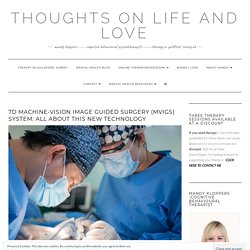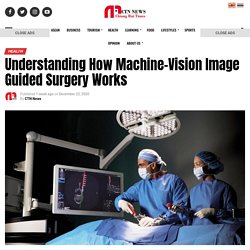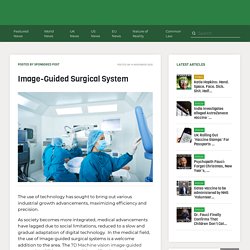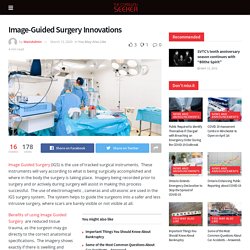

7D Surgical
7D Surgical is at the helm of image guided surgery innovation. Born out of an unwavering commitment to empower surgeons and improve healthcare around the world, the company’s versatile multi-applications platform is reimagining the way some of the most sensitive and complicated procedures are performed. The system is cost-effective and radiation-free.
7D Machine-vision Image Guided Surgery (MvIGS) System: All about This New Technology - Thoughts on Life and Love. The Machine-vision Image Guided Surgery (MvIGS) System is a recent and promising invention in the medical field.

It is the first of its kind and the only image guidance system that uses new camera-based technology and machine vision algorithms to aid surgeons during complex surgeries. The 7D Surgical System eliminates the need for those involved in the surgical procedure to be exposed during radiation, which is a notable difference from traditional image guidance systems. This innovative technology makes image guided surgery faster, more cost-effective, more accurate, and free of radiation.
A Safer Experience For past years most surgeons used 2D fluoroscopy during spine surgeries, which involves the use of x-rays to get images of internal parts. A More Accurate Operation 7D’s MvIGS system uses their Flash™ Registration and Flash™ Fix technology to provide true segmental registration in regard to the spine’s vertebrates.
Understanding How Machine-Vision Image Guided Surgery Works. There continues to be a breakthrough after breakthrough in the medical field.

One of the latest technologies to be discovered is machine vision image-guided surgery or MvIGS. In this type of surgery, a surgeon is able to use the machine to see inside the patient, rather than using point matching techniques or intraoperative radiation. With this technology, the patient, doctor, and nurse’s safety is taken into account as they will no longer need to be exposed to the radiation one would experience when using an X-Ray. Image-Guided Surgical System – David Icke. The use of technology has sought to bring out various industrial growth advancements, maximizing efficiency and precision.

As society becomes more integrated, medical advancements have lagged due to social limitations, reduced to a slow and gradual adaptation of digital technology. Spine and Cranial Navigation: The Latest Surgical Technology. In recent years, spine and cranial navigation has come into prominence as the latest technological innovation in the medical field.

In particular, Image Guided Surgery (IGS) systems have recently allowed surgeons to perform radiation-free spinal and cranial navigation, efficiently and cost effectively. This type of technology is especially important in cases that high surgical accuracy is required, as is often used by neurosurgery and orthopedic surgeons. Best of all, it is considered much safer with less potential side effects than other types of surgeries.
This type of navigation is increasingly becoming utilized in operating rooms worldwide with greater frequency. In addition, various studies are taking place to determine future outlook. Spine and Cranial Navigation: The Latest Surgical Technology. An In-Depth Review of Image-Guided Surgical Systems - All Peers. For the past two decades, surgeons have implemented various surgery methods and technologies to aid safe and successful procedures on patients.

However, in recent times, computer-based solutions have augmented the medical field – thanks to the advancement in technology. One notable application that plays an essential role in several surgical operations is Image-Guided Surgery (IGS). This advanced navigational system makes it easy for surgeons to perform complex, but less invasive operations, including the removal of malignant tumours. Gone are those days when it was impossible to operate on these cancerous tumours due to their sheer size and accessibility. Spine and Cranial Navigation: The Latest Surgical Technology. Advancements in the World of Neurological Surgeries - Top.me. Our understanding of the human body has been reworked and re-examined as time has gone by.

This has led to us reaching a variety of thresholds over the years, event horizons that redefine how we look at the treatment or diagnosis of the many ailments we experience over the course of our lives. One of the most complicated areas of our sometimes fragile bodies exists in the realm of neurosurgery. The kind of conditions that fall under the purvey of neurosurgery, while not always necessarily life-threatening, are intertwined with the most complex component that we have; our nervous system. The reason it is so complex is that it assumes a central role in nearly every single part of our overall health. Using Images To Safely Navigate Inside The Head: Cranial Navigation (Image Guided Surgery) - Toronto Times. The use of live images for investigative and diagnostic purposes first became available in the mid-1980s.

The next logical step was the use of those images to guide surgery and particularly craniotomies. Advances in the technology now allow images that were generated for diagnostic purposes to be used in concert with live images that are generated in the operating room and during an operation. These diagnostic images are used to “map” the operation using a computer and specialised applications.
Increasing use is being made of robotics so the surgical instruments to be used in the surgery are connected to, and tracked by, computers. High resolution images enable surgeons to conduct surgery more accurately and precisely especially inside the skull. Technological advancement The images used as part of the operating procedure are “collected” using a hand-held probe. As already noted, integral to image guided surgery is the mechanism for tracking what happens during an operation.
Like this: Image-Guided Surgery. Benefits and Uses of Machine-Vision Image-Guided Surgery (MvIGS) Technology has been gradually advancing and developing over the years past, especially when it comes to medicine.

Recent Advances in Spinal Navigation Surgery Technology - YEG Fitness. Top.

Image-Guided Surgery Innovations - The Seeker Newspaper Cornwall. Image Guided Surgery (IGS) is the use of tracked surgical instruments.

These instruments will vary according to what is being surgically accomplished and where in the body the surgery is taking place. Imagery being recorded prior to surgery and or actively during surgery will assist in making this process successful. The use of electromagnetic , cameras and ultrasonic are used in the IGS surgery system. The system helps to guide the surgeons into a safer and less intrusive surgery, where scars are barely visible or not visible at all. Image Guidance as an Invaluable Tool for Spine Navigation. Image-Guided Surgery Systems.
Image-Guided Surgery Systems. How Image Guided Surgery Systems Are Making Procedures Safer and Faster. Technological developments have driven so much change in all aspects of daily lives, particularly in the last few decades. A prominent area of change is within healthcare, where new computerized innovations, such as image guided surgery systems, sit alongside clinical research breakthroughs to literally make the difference between life and death. Image-Guided Surgery Systems: The Newest Innovation in Healthcare - Curious Mind Magazine. Technological advances in healthcare have vastly improved patient care and surgery outcomes over the past 30 years. In effect, these advances are improving our quality of life. In particular, Image-Guided Surgery Systems (IGS) have become the official standard of healthcare over the past 10 years. IGS systems are often applied in neurology, orthopedics, otorhinolaryngology, ophthalmology, cardiology, urology, gynecology, gastroenterology, dentistry, and cancer treatment.
Specifically, they often deal with cranial, otorhinolaryngological, spinal, orthopedic, and cardiovascular disorders. IGS technology continues to grow at a rapid-pace, as a minimally invasive and safe surgical innovation. What is IGS? IGS is also known as surgical navigation and combines navigation technology, image acquisition, and image processing. Can Innovation In Surgical Technology Change The Outcomes For Gunshot Patients? Gunshot injury is one the most frequent causes of penetrating brain injury.
Mortality rates for surviving such a gunshot injury are painting a dark picture: between 52 and 95% do not survive the surgical treatment. Unfortunately, cases of cranio-cerebral gunshot injuries are now more and more frequent on surgeons’ operating tables from all around the world. A penetrating brain injury wound occurs when the bullet or any other projectile ruptures the cranium but does not exit it. The lives of those who survive such an injury is very much time dependent. The medical standard involves aggressive resuscitation upon hospital arrival and if proper oxygenation to the brain is maintained, surgery.
There are a number of surgical procedures that can be performed, conventionally craniotomy and craniectomy are the main options. Are Image-Guided Surgery Systems Safe? - Baltimore Post-ExaminerBaltimore Post-Examiner. As technology advances and brings in more and more revolutions in different fields, so do people’s unfamiliarity with them, which raises questions, and even a little bit of fear. Fear is always alleviated with a bit of knowledge, however. The amazing technology behind image-guided surgery systems - Henpicked. Nowadays, we can see a brain lobe, nasal cavities, a vertebrae’s structure in somebody’s spine—and explore just about anything in any person’s body with image-guided surgery systems. Imagine guided surgery systems are providing surgeons around the world with the next generation in medical technology.
Image-guided surgery systems offer plenty of solutions and benefits to patients requiring operations. By revolutionizing the standard surgical techniques, image-guided surgery systems allow doctors to see inside a person’s body using third-dimensional images. Also, these images offer the ability to alter themselves so that a surgeon witnesses a level of detail beyond what’s been available in operating rooms before with image-guided surgery systems.
Image-Guided Surgery Systems A Proven Success. Surgery has had a long and fascinating evolution throughout human history. This field of medicine has culminated in the inclusion of many different forms of technology to ensure that today’s approach to these complex procedures is as safe and effective as possible. There have been many innovations in the past fifty years in this field, but it’s image-guided surgery systems that is the newest and among the most significant. Visit 7D Surgical to understand how it works. To understand just how important this latest innovation in surgery is, we must look at the past of this miraculous field of medicine. Our modern ideas of surgery would imply that it is a fairly new idea involving sterilized instruments and operating theatres, but surgery actually goes all the way back to the stone age!
The Technology Empowering Neurosurgeons To Extend Lives and Fight Cancer. Back pain is one of our modern world’s biggest health enemies. About 85% of working people are expected to suffer from this in their lifetimes. And while in some cases, it can be alleviate though medication and physical therapy, in others, surgery is the only way to go. Brain and spinal cord cancers are one of such situations. Latest figures available for Canada show that at least 3,000 men and women were diagnosed with brain and spinal cord cancer.
Brain Surgeons Can Now Use Machine-Vision Image Guided Surgery (MvIGS) - South Florida Reporter. 5 Leading Clinical Applications of Image-guided Surgical Systems. The Fundamentals of Image-Guided Surgery. How Image Guided Surgical Systems Are Saving Lives - Vaunte. The New 7D Surgical Invention.